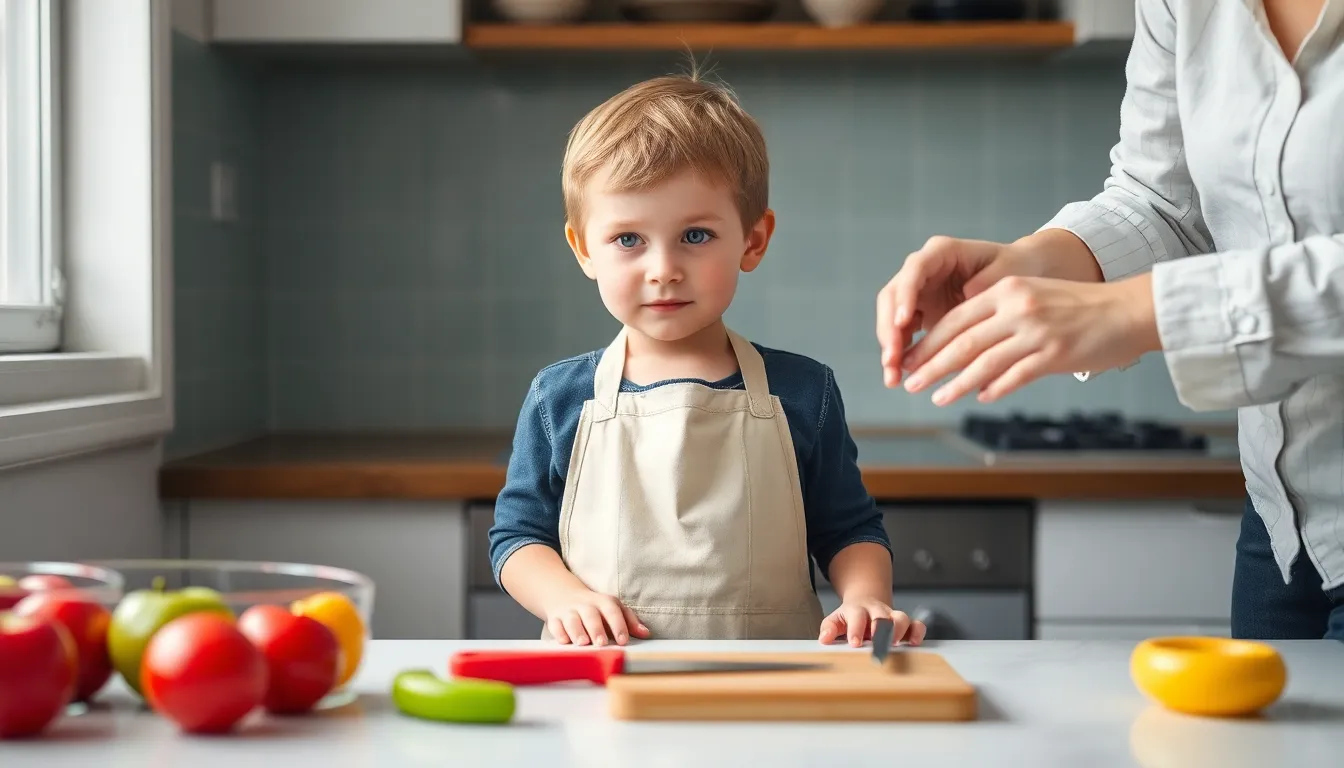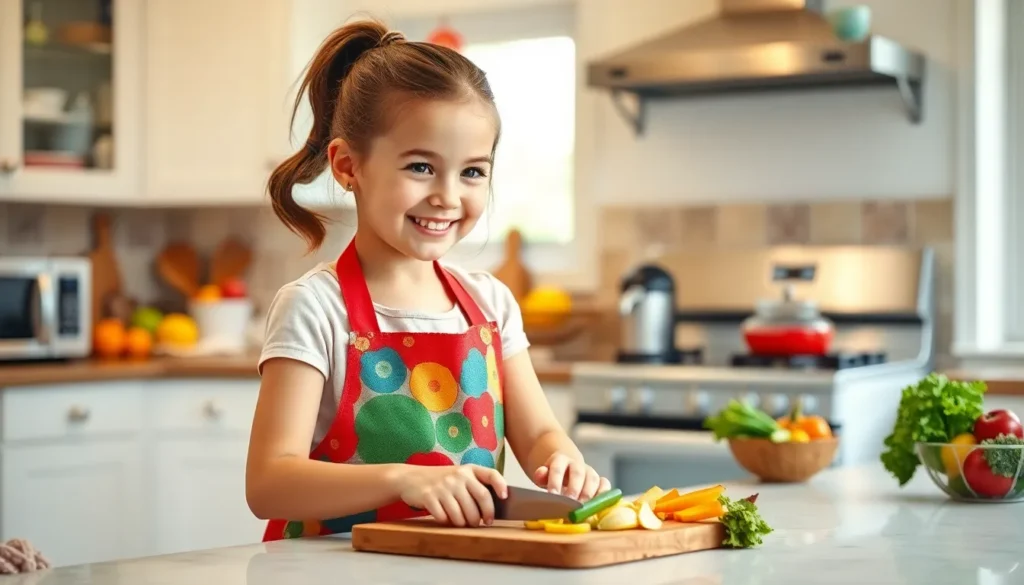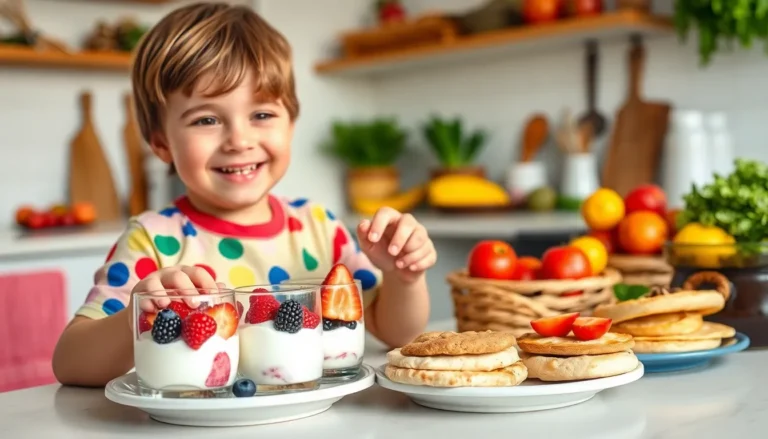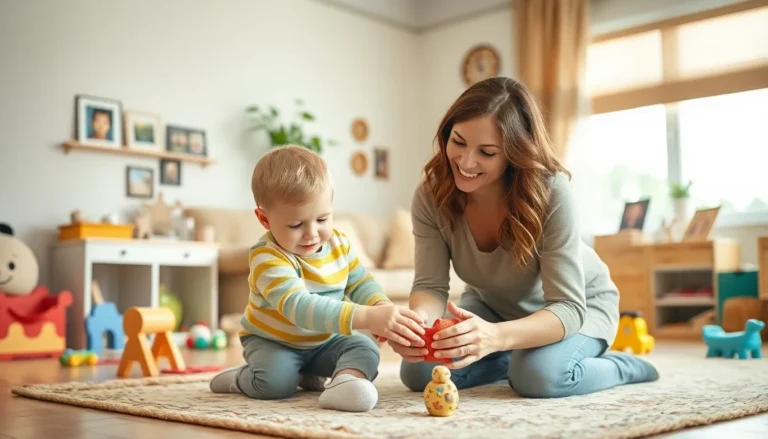Table of Contents
ToggleEvery parent knows that the kitchen can be a chaotic wonderland, filled with delicious aromas and the occasional flying spatula. But when kids enter this culinary playground, safety should be the main ingredient. Teaching children about kitchen safety isn’t just smart; it’s essential. After all, no one wants a surprise visit from the fire department during a pancake breakfast!
Importance Of Kitchen Safety For Kids
Kitchen safety holds paramount importance when involving kids in cooking activities. Accidents in the kitchen can occur quickly, leading to injuries or even fires. Teaching children proper safety measures encourages responsibility and awareness. Practical knowledge about kitchen tools and equipment prevents misuse, which often results in accidents.
Fires represent one of the highest risks in home kitchens. An understanding of fire hazards, such as grease or flammable materials, can help children react appropriately. Gathering important information about fire safety techniques ensures that kids know what to do in emergency situations.
Cuts from knives or other sharp objects rank among frequent kitchen injuries. Educating children about safe knife handling techniques reduces the likelihood of deep cuts. Additionally, supervision during cooking sessions helps maintain a safe environment while kids practice their skills.
Hot surfaces, such as stovetops and ovens, pose another significant danger. An awareness of temperature hazards educates children to stay at a safe distance. Calling attention to things like wearing oven mitts also minimizes the risk of burns during cooking.
Promoting cleanliness in the kitchen contributes to overall safety. Teaching kids to clean spills and keep utensils organized limits the chances of slipping or tripping. Maintaining a clutter-free workspace encourages focus and reduces distractions.
Engaging children in discussions about kitchen safety instills lifelong habits. Continuous reminders and cool-down sessions reinforce their understanding of safety principles. Through consistent education, kids develop a strong foundation for safe cooking practices.
Common Kitchen Hazards

Kitchens present various hazards that require vigilant awareness, especially for children. Recognizing these dangers promotes safer cooking environments.
Sharp Objects
Knives pose a significant risk in the kitchen. They can cause cuts and other injuries if handled improperly. It’s crucial for kids to learn safe knife techniques. Using child-safe utensils or cut-resistant gloves minimizes risks further. Storing knives out of reach prevents accidents as well. Teaching children to always cut away from their bodies eliminates potential injuries.
Hot Surfaces
The kitchen stove, oven, and hot pots represent serious burn hazards. Children must understand that these surfaces can reach extreme temperatures. Always using oven mitts when handling hot items reduces burn risks. Waiting for things to cool down before touching them promotes safety, too. Installing stove knob covers prevents accidental usage, offering an extra layer of protection.
Cleaning Supplies
Household cleaning supplies often contain hazardous chemicals. Children should never handle these products without adult supervision. Proper storage in high cabinets reinforces safety. Educating kids about the dangers of ingesting or spilling chemicals is vital. Using non-toxic cleaners can also mitigate health risks. Keeping all supplies labeled and stored properly enhances overall kitchen safety.
Teaching Kids About Kitchen Safety
Teaching children about kitchen safety involves engaging them in practical experiences and assigning appropriate responsibilities. Understanding safety measures helps children enjoy cooking while staying safe.
Age-Appropriate Responsibilities
Assigning tasks according to a child’s age ensures they learn kitchen safety effectively. Younger children can help with washing vegetables or stirring ingredients. As kids grow, they can learn to measure ingredients and assist with food preparation. Older children may tackle more complex tasks like using a can opener or helping with basic cooking on the stove. Establishing clear guidelines helps children recognize their capabilities and limitations. Relevant supervision enables safe learning experiences and builds confidence in their skills.
Hands-On Learning
Incorporating hands-on learning reinforces kitchen safety concepts. Practical demonstrations, like using a cutting board and a child-safe knife, show safe cutting techniques. Engaging children in cooking activities deepens their understanding of fire hazards, such as identifying flame sources on the stove. Through real experiences, kids practice safety skills, such as using oven mitts and keeping pot handles turned inward. Encouraging questions during cooking sessions fosters curiosity and allows parents to address safety concerns promptly.
Essential Safety Tips For Parents
Parents must prioritize kitchen safety for their children to foster confidence and responsibility. Implementing specific guidelines makes cooking a fun and safe experience.
Supervision Guidelines
Always supervise children while they’re in the kitchen. Close monitoring prevents accidents and allows for immediate intervention if necessary. Ensure that they understand when adult help is required, especially with tasks involving sharp objects or hot surfaces. Depending on their age, provide age-appropriate tasks, enhancing their skills while maintaining safety. Establish a safe cooking zone where children can engage without disturbing high-risk areas like the stove. Regularly check in with them as they work, promoting open communication about any safety concerns that might arise during the cooking process.
Setting Safety Boundaries
Set clear safety boundaries to eliminate confusion and promote awareness. Designate specific areas of the kitchen that are off-limits without adult supervision, such as the oven or sharp utensil storage. Implement rules regarding the use of kitchen equipment, ensuring children know which tools are safe for their age group. Encourage the use of child-safe utensils designed with safety features, reducing the risk of injury. Explain the reason behind each rule, fostering an understanding of safety concepts in relation to their cooking activities. By establishing these boundaries early, parents create a secured environment where children feel empowered to learn.
Fun Activities To Promote Safety Awareness
Creating a fun and engaging environment helps children understand kitchen safety. Cooking-themed games can reinforce safety concepts while capturing their interest.
- Safety Scavenger Hunt: Parents can set up a scavenger hunt in the kitchen. This activity encourages kids to identify potential hazards like knives, hot surfaces, and cleaning supplies. Kids learn to recognize dangers while enjoying the thrill of the hunt.
- Cooking Safety Role Play: Role-playing scenarios allows children to practice safety skills. Assign roles like “chef” and “safety monitor.” This setup provides opportunities to demonstrate safe practices, such as using oven mitts and safely handling knives.
- Safety Poster Creation: Engaging kids in creating colorful posters about kitchen safety fosters creativity. They can illustrate essential safety tips and display posters in the kitchen. Visual reminders reinforce messaging and make safety a part of the kitchen decor.
- Interactive Cooking Sessions: Involving children in hands-on cooking sessions strengthens their safety awareness. Parents can explain safety rules during each step, such as proper knife handling and managing hot pots. Interactive participation deepens understanding and builds confidence.
- Recipe Safety Reviews: Before cooking, reviewing a recipe together can highlight safety measures. Discuss necessary precautions for each ingredient or step. This practice prepares kids for what to expect and empowers them to take responsibility.
- Kitchen Safety Quiz: Hosting a fun quiz night focused on kitchen safety can challenge kids. Invite them to answer questions about safe practices, such as the importance of cleaning spills. Quizzes reinforce knowledge through a competitive and enjoyable format.
Integrating these activities promotes kitchen safety awareness while making learning enjoyable. Kids develop essential skills, ensuring they remain safe and confident during cooking experiences.
Kitchen safety for kids is vital in fostering a secure cooking environment. By teaching children about potential hazards and safe practices, parents can empower them to take responsibility in the kitchen. Encouraging hands-on experiences and open discussions about safety not only builds confidence but also instills lifelong habits.
Creating a safe cooking zone and implementing clear guidelines can significantly reduce risks. Engaging activities like safety scavenger hunts and cooking quizzes make learning enjoyable and memorable. Ultimately, prioritizing kitchen safety helps children develop essential skills while nurturing their passion for cooking.







